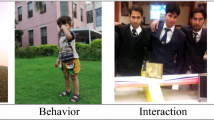Abstract
The safety helmet wearing of workers is extremely important to their safety in construction scenarios, and it is very meaningful for computer vision, pattern recognition and artificial intelligence. This paper proposes a new Improved Boosted Random Ferns algorithm (IBRFs) for safety helmet wearing status detection. IBRFs originates from the Boosted Random Ferns algorithm (BRFs) and introduces the weighted coefficient to improve. In IBRFs, firstly, the feature is extracted by Histogram of Oriented Gradient (HOG) to form the feature domain space of the image. Secondly, the random binary test method is used to construct random ferns in the feature domain space. Then, a weak (acceptable) classifier is constructed by random ferns. Finally, an improved Real AdaBoost algorithm is used to select the most discriminative ones to construct IBRFs. Experimental evaluation on an enlarged public Safety Helmet Wearing-datasets (GZMU-SHWD) shows that the result of IBRFs outperforms those of the existing advanced detection algorithms, including SSD, YOLOv3 and Faster R-CNN, which further demonstrates the effectiveness of IBRFs for safety helmet wearing status detection.








Similar content being viewed by others
Notes
The SWHD database: [Online]. Available: https://github.com/njvisionpower/Safety-Helmet-Wearing-Dataset#model, October 11, 2019.
References
Bahaa E, Mneymneh et al (2017) Automated hardhat detection for construction safety applications[J]. Procedia Eng 196:895–902
Cai L, Qian J (2011) A method for detecting miners based on helmets detection in underground coal mine videos[J]. Min Sci Technol (China) 21(4):553–556
Cheng R, He X, Zheng Z, Wang Z (2021) Multi-scale safety helmet detection based on SAS-YOLOv3-tiny [J]. Appl Sci 11(8):3652–3652
Dalal N, Triggs B (2005) Histograms of oriented gradients for human detection[C]. Comput Vis Pattern Recognit 33(9):886–893
Fang M, Sun TT, Sao Z (2019) Fast helmet wearing detection based on improved yolov2 [J]. Opt Precis Eng 27(05):1196–1205
Ferrari V, Fevrier L, Jurie F, Schmid C (2008) Groups of adjacent contour segments for object detection. IEEE Trans Pattern Anal Mach Intell 30(1):36–51. https://doi.org/10.1109/TPAMI.2007.1144
Freund Y (1995) Boosting a weak learning algorithm by majority [J]. Inf Comput 121(2):256–285
Girshick R, Donahue J, Darrell T, Malik J (2014) Rich feature hierarchies for accurate object detection and semantic segmentation. 2014 IEEE Conference on Computer Vision and Pattern Recognition, pp 580–587. https://doi.org/10.1109/CVPR.2014.81
Jebril NA, Al-Zoubi HR, Abu Al-Haija Q (2018) Recognition of handwritten Arabic characters using histograms of oriented gradient (HOG). Pattern Recognit Image Anal 28:321–345. https://doi.org/10.1134/S1054661818020141
Lowe DG (2004) Distinctive image features from scale-invariant keypoints[J]. Int J Comput Vis 60(2):91–110
Martinez M, Yang K, Constantinescu A, Stiefelhagen R (2020) Helping the blind to get through covid-19: social distancing assistant using real-time semantic segmentation on rgb-d video. Sensors (Switzerland) 20:1–17. https://doi.org/10.3390/s20185202
Ojala T, Pietikainen M, Maenpaa T (2002) Multiresolution gray-scale and rotation invariant texture classification with local binary patterns[J]. IEEE Trans Pattern Anal Mach Intell 24(7):971–987
Park MW, Elsafty N, Zhu ZH (2015) Hardhat-wearing detection for enhancing on-site safety of construction workers [J]. J Constr Eng Manag 141(9):1–16
Redmon J, Divvala S, Girshick R, Farhadi A (2016) You only look once: unified, real-time object detection. 2016 IEEE Conference on Computer Vision and Pattern Recognition (CVPR), pp 779–788. https://doi.org/10.1109/CVPR.2016.91
Ren S, He K, Girshick R, Sun J (2017) Faster R-CNN: towards real-time object detection with region proposal networks [J]. IEEE Trans Pattern Anal Mach Intell 39(6):1137–1149
Schapire RE, Singer Y (1999) Improved boosting algorithms using confidence-rated predictions [J]. Mach Learn 37(3):297–336. https://doi.org/10.1023/A:1007614523901
Shi T, Niu Y, Liu M, Yang Y, Wang C, Huang Y (2019) Underwater dense targets detection and classification based on YOLOv3. 2019 IEEE International Conference on Robotics and Biomimetics (ROBIO), pp 2595–2600. https://doi.org/10.1109/ROBIO49542.2019.8961615
Siebert FW, Lin H (2020) Detecting motorcycle helmet use with deep learning. Accid Anal Prev 134:105319. https://doi.org/10.1016/j.aap.2019.105319
Thakar V, Saini H, Ahmed W, Soltani MM, Aly A, Yu JY (2018) Efficient single-shot multibox detector for construction site monitoring. 2018 IEEE International Smart Cities Conference (ISC2), pp 1–6. https://doi.org/10.1109/ISC2.2018.8656929
Villamizar M, Moreno-Noguer F, Andrade-Cetto J, Sanfeliu A (2010) Shared random ferns for efficient detection of multiple categories. 2010 20th International Conference on Pattern Recognition, pp 388–391. https://doi.org/10.1109/ICPR.2010.103
Villamizar M, Andrade-Cetto J, Sanfeliu A, Moreno-Noguer F (2012) Bootstrapping boosted random ferns for discriminative and efficient object classification [J]. Pattern Recogn 45(9):3141–3153
Villamizar M, Andrade-Cetto J, Sanfeliu A, Moreno-Noguer F (2018) Boosted random ferns for object detection. IEEE Trans Pattern Anal Mach Intell 40(2):272–288. https://doi.org/10.1109/TPAMI.2017.2676778
Wang B, Chen F, Deng P (2014) Online object tracking based on sparse subspace representation. The 26th Chinese Control and Decision Conference (2014 CCDC), pp 3975–3980. https://doi.org/10.1109/CCDC.2014.6852876
Wu F, Jin G, Gao M, He Z, Yang Y Helmet detection based on improved YOLO V3 deep model. 2019 IEEE 16th International Conference on Networking, Sensing and Control (ICNSC), pp 363–368. https://doi.org/10.1109/ICNSC.2019.8743246
Xudong C, Yichen W, Fang W et al (2014) Face alignment by explicit shape regression [J]. Int J Comput Vis 107(2):177–190
Yokoya M, Iwasaki A (2015) Generalized-hough-transform object detection using class-specific sparse representation for local-feature detection. 2015 IEEE International Geoscience and Remote Sensing Symposium (IGARSS), pp 2852–2855. https://doi.org/10.1109/IGARSS.2015.7326409
Zhang J, Yang K, Stiefelhagen R (2020) ISSAFE: improving semantic segmentation in accidents by fusing event-based data. arXiv preprint arXiv:2008.08974
Acknowledgments
The work is supported by National Natural Science Foundation of China (61802082, 61762020, 61263034), Guizhou Provincial Department of Education (Qian Jiao He KY ZI [2018] 018) .
Author information
Authors and Affiliations
Corresponding author
Additional information
Publisher’s note
Springer Nature remains neutral with regard to jurisdictional claims in published maps and institutional affiliations.
Rights and permissions
About this article
Cite this article
Yue, S., Zhang, Q., Shao, D. et al. Safety helmet wearing status detection based on improved boosted random ferns. Multimed Tools Appl 81, 16783–16796 (2022). https://doi.org/10.1007/s11042-022-12014-y
Received:
Revised:
Accepted:
Published:
Issue Date:
DOI: https://doi.org/10.1007/s11042-022-12014-y




